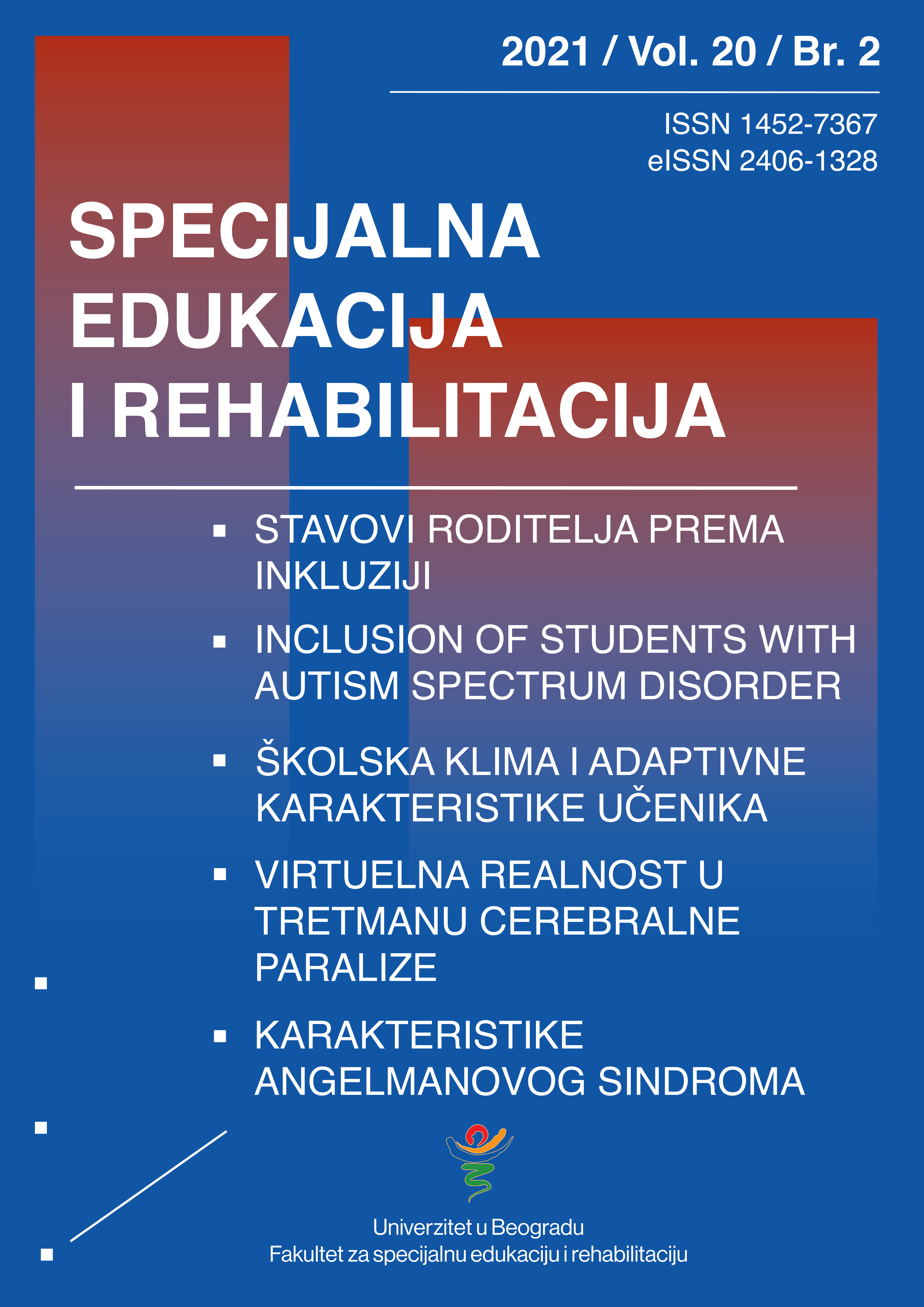Inkluzija učenika s poremećajem iz spektra autizma u redovna odeljenja u Jordanu: Perspektiva nastavnika
Sažetak
Uvod: Ova studija je fokusirana na značaj uključivanja učenika s poremećajem iz spektra autizma (PSA) u redovna odeljenja. Ovo pitanje je steklo međunarodno priznanje s preporukama većine zemalja da ovim učenicima treba pružiti iste mogućnosti kao i onima bez ometenosti. Za ovo istraživanje odabran je slučaj jordanskih učitelja u Amanu. Cilj: Cilj istraživanja bio je da se ispita stanovište nastavnika o uključivanju učenika sa PSA u redovna odeljenja u Jordanu. Metode: Problem je ispitan primenom studije kvalitativnog dizajna, gdje je virtualno intervjuisano devet nastavnika. Rezultati: Nalazi su ukazali na potrebu za boljom obukom i razvojem veština o određenim aspektima i potrebama učenika sa PSA. Obezbeđivanje obuke za nastavnike, kao i materijane i finansijske podrške neophodni su za podržavanje inkluzivnog učenja. Nastavnici su takođe izvestili o značajnim ograničenjima u pogledu načina na koji se podržava inkluzija učenika sa PSA u Jordanu. Kada je reč o inkluziji učenika sa PSA u Jordanu, njihovi nastavnici, zbog neadekvatne obuke i nedovoljnog iskustva, imaju manjak samopouzdanja i nisko vrednuju vlastite sposobnosti za rad sa ovim učenicima i organizovanje inkluzivnog razreda. Zaključak: Nalazi ove studije ukazuju na potrebu da kreatori politike u Jordanu razmotre mogućnost pružanja posebne obuke svojim nastavnicima specijalne edukacije.
Reference
Abu-Hamour, B., & Muhaidat, M. (2014). Parents’ attitudes towards inclusion of students with autism in Jordan. International Journal of Inclusive Education, 18(6), 567-579. doi.org/10.1080/13603116.2013.802026
American Psychiatric Association (APA). (2013). Diagnostic and statistical manual of mental disorders: Fifth edition DSM-V. Publisher.
Bailey, R. A. (2008). Design of comparative experiments. Cambridge University Press Cambridge. https://doi.org/10.1017/CBO9780511611483
Ballard, K. (2012). Inclusion and social justice: Teachers as agents of change. In S. Carrington, & J. Macarthur (Eds.), Teaching in inclusive school communities (pp. 65-87). John Wiley & Sons.
Centers for Disease Control and Prevention (CDC). (2014). CDC estimates 1 in 68 children has been identified with autism spectrum disorder. https://www.cdc.gov/media/releases/2014/p0327-autism-spectrum-disorder.html
Chandler-Olcott, K., & Kluth, P. (2009). Why everyone benefits from including students with autism in literacy classrooms. The Reading Teacher, 62(7), 548-557. https://doi.org/10.1598/RT.62
Chhabra, S., Srivastava, R., & Srivastava, I. (2010). Inclusive education in Botswana: The perceptions of school teachers. Journal of Disability Policy Studies, 20(4), 219-228. https://doi.org/10.1177/1044207309344690
Chung, W., Edgar-Smith, S., & Palmer, R. (2015). An examination of in-service teacher attitudes toward students with autism spectrum disorder: Implications for professional practice. Current Issues in Education, 18(2), 1-10.
Creswell, J. W. (2013). Qualitative inquiry and research design: Choosing among five approaches (3rd ed.). Sage.
Denning, C. B., & Moody, A. K. (2013). Supporting students with autism spectrum disorders in inclusive settings: Rethinking instruction and design. Electronic Journal for Inclusive Education, 3(1), Article 6.
Fettig, A., Meadan, H., Michna, A., Ostrosky, M. M., & Triplett, B. (2011). Using visual supports with young children with autism spectrum disorder. Teaching Exceptional Children, 43(6), 28-35. https://doi.org/10.1177/004005991104300603
Higher Council for the Rights of Persons with Disabilities. (2017). Law on the Rights of Persons with Disability. http://hcd.gov.jo/en
Hintz, A.-M., Urton, K., Krull, J., Wilbert, J., & Hennemann, T. (2015). Teachers’ perceptions of opportunities and threats concerning inclusive schooling in Germany at an early stage of inclusion: Analyses of a mixed methodology approach. Journal of Cognitive Education and Psychology, 14(3), 357-374. https://doi.org/10.1891/1945-8959.14.3.357
Humphrey, N., & Symes, W. (2013). Inclusive education of pupils with autistic spectrum disorders in secondary mainstream schools: Teacher attitudes, experience and knowledge. International Journal of Inclusive Education, 17(1), 32-46. https://doi.org/10.1080/13603116.2011.580462
Khochen, M., & Radford, J. (2012). Attitudes of teachers and head-teachers towards inclusion in Lebanon. International Journal of Inclusive Education, 16(2), 139-153. https://doi.org/10.1080/13603111003671665
Koegel, L. K., Singh, A. K., & Koegel, R. L. (2010). Improving motivation for academics in children with autism. Journal of Autism and Developmental Disorders, 40, 1057-1066. https://doi.org/10.1007/s10803-010-0962-6
Leach, D., & Duffy, M. L. (2009). Supporting students with autism spectrum disorders in inclusive settings. Intervention in School and Clinic, 45(1), 31-37. https://doi.org/10.1177/1053451209338395
Lindsay, S., Proulx, M., Scott, H., & Thompson, N. (2014). Exploring elementary school teachers’ strategies for including children with autism spectrum disorder in mainstream classroom classes. International Journal of Inclusive Education, 18(2), 101-122. https://doi.org/10.1080/13603116.2012.758320
Majoko, T. (2018). Practices that support the inclusion of children with autism spectrum disorder in mainstream early childhood education in Zimbabwe. International Journal of Special Education, 33(3), 630-656.
Mandell, D. S., Stahmer, A. C., Shin, S., Xie, M., Reisinger, E., & Marcus, S. C. (2013). The role of treatment fidelity on outcomes during a randomized field trial of an autism intervention. Autism, 17(3), 281-295. https://doi.org/10.1177/1362361312473666
Pellecchia, M., Connell, J. E., Beidas, R. S., Xie, M., Marcus, S. C., & Mandell, D. S. (2015). Dismantling the active ingredients of an intervention for children with autism. Journal of Autism and Developmental Disorders, 45(9), 2917-2927. https://doi.org/10.1007/s10803-015-2455-0
Pugach, M. C., Mukhopadhyay, A., & Gomez-Najarro, J. (2014). Finally making good on the promise of qualitative research in special education? A response to the special issue. Remedial and Special Education, 35(6), 340-343. https://doi.org/10.1177/0741932514545790
Reupert, A., Deppeler, J., & Sharma, U. (2015). Enablers for inclusion: The perspectives of parents of children with autism. Australasian Journal of Special Education, 39(1), 85-96. https://doi.org/10.1017/jse.2014.17
Sakarneh, M. (2014). Jordanian education reform between the ideal and the actual. Developing Country Studies, 4(20), 65-73.
Sakarneh, M. (2016). The Applicability of the NSW Quality Teaching Model to the Jordanian primary school context. Dirasat: Educational Sciences, 43(Suppl. 4), 1773-1789.
Sakarneh, M. A., Sabayleh, O. A., & Alramamneh, A. L. K. (2019). The sensory characteristics of children with autism spectrum disorder: Teachers’ observation. International Journal of Early Childhood Special Education, 11(2), 105-115. https://doi.org/10.20489/intjecse.670459
Sakarneh, M. (2020). The challenges facing teachers in inclusion of students with special needs in the Jordanian basic schools from the teachers’ point of view (in Arabic). Dirasat: Educational Sciences, 47(2), 90-102.
Sva prava zadržana (c) 2021 Specijalna edukacija i rehabilitacija

Ovaj rad je pod Creative Commons Autorstvo-Deli pod istim uslovima 4.0 međunarodnom licencom.

